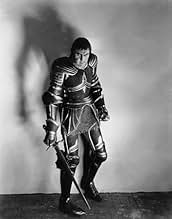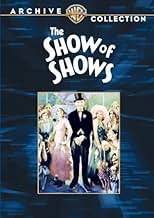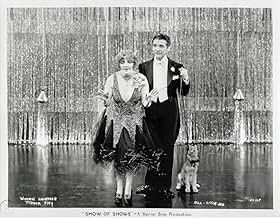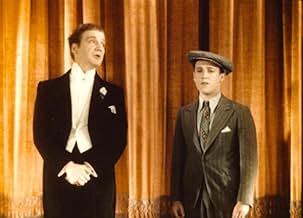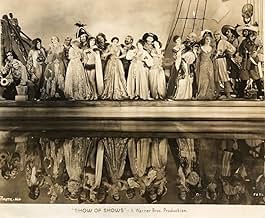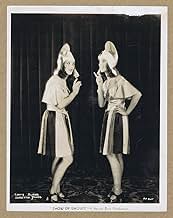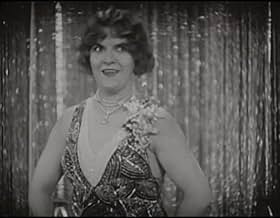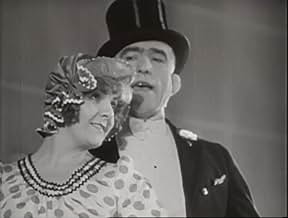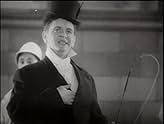Agrega una trama en tu idiomaIn 1929, the studio gave the cinema its voice and offered audiences a chance to hear their favorite actors and actresses from the silent-screen era. For the first time, they can be heard in ... Leer todoIn 1929, the studio gave the cinema its voice and offered audiences a chance to hear their favorite actors and actresses from the silent-screen era. For the first time, they can be heard in a gaudy, grandiose musical-comedy revue. But also appearing are actors and actresses from ... Leer todoIn 1929, the studio gave the cinema its voice and offered audiences a chance to hear their favorite actors and actresses from the silent-screen era. For the first time, they can be heard in a gaudy, grandiose musical-comedy revue. But also appearing are actors and actresses from the first 'talkies', stars from Broadway, and, of course, German shepherd Rin-Tin-Tin. Fra... Leer todo
- Dirección
- Guionistas
- Elenco
- Premios
- 2 premios ganados en total
- Performer in 'Meet My Sister' Number
- (as Mimi Vendrell)
- Joe Burke
- (as Joe Burke)
- Dirección
- Guionistas
- Todo el elenco y el equipo
- Producción, taquilla y más en IMDbPro
Opiniones destacadas
Generally superior, I think, to MGM's "Hollywood Revue of 1929," and worth watching if you can
Contributing also as a writer, host Frank Fay does a good job. The studio's biggest star at the time was Richard Barthelmess (rising from #8 in 1928 to #7 in 1929 according to the annual Quigley Poll of Box Office stars); he does not sing or dance, preferring to briefly appear as a dignified presenter. The legendary Al Jolson does not appear at all, but Sid Silvers imitates him well. John Barrymore contributes a fine excerpt as "Richard III" from "Henry VI" - rare celluloid from the Shakespearian maestro...
Another highlight is the biggest hit song from the show, "Lady Luck" performed memorably by band-leader Ted Lewis (who took it to #3 on the record charts) and singer-guitarist Nick Lucas (who helped keep Lewis from rising higher by locking down #1 for ten weeks with his "Tip Toe Through the Tulips"). Of the many cover versions, "Singin' in the Bathtub" (a good-natured poke at MGM's "Singin' in the Rain") rose to #10 in a version by Guy and Carmen Lombardo; here, Winnie Lightner contributes a vibrant version.
***** The Show of Shows (11/21/29) John G. Adolfi ~ Frank Fay, Nick Lucas, Winnie Lightner, John Barrymore
The movie is quite a spectacle, though nowadays its value is mostly as a curiosity for hardcore film buffs. The songs generally aren't that great and the performances aren't always polished, though everybody seems to be having fun. Much of the cast is made up of largely forgotten stars of the late silent/early sound era that most modern viewers wouldn't recognize. But it's a real treat for film historians.
I'm a big fan of old movies and classic Hollywood, and many of the featured stars are obscure even to me. Most of the stars are identified at some point in the film, though countless others are mixed into scenes with little fanfare. Without identification I was able to spot Myrna Loy, Ben Turpin, Chester Morris, Richard Barthelmess, Douglas Fairbanks Jr., John Barrymore, and Monte Blue. And I'm familiar, to varying degrees, with people like Frank Fay, Winnie Lightner, Louise Fazenda, Dolores Costello, Noah Beery, and Tully Marshall.
Frank Fay emcees the proceedings, tying the various acts together and introducing the stars. His verbal comedy shtick is a good fit for talkies and he does a pretty good job.
An early highlight is Winnie Lightner's upbeat comedy song "Ping Pongo". Louise Fazenda, Fay, Lloyd Hamilton, and Beatrice Lillie do a recitation sketch that's pretty funny, though it stretches a little too long. There's a number featuring notable screen villains as pirate versions of themselves (singing pirates, naturally). Another features several pairs of movie star sisters, including Loretta Young and Sally Blane, who look freakishly alike. Lightner also sings "Singin' in the Bathtub", a tune I know from old Looney Tunes cartoons. John Barrymore hams it up with a Shakespeare soliloquy as Richard III.
I was surprised and delighted halfway through to see an exotic number in two-strip Technicolor. Apparently most of the film was shot in color, but the surviving print is in black & white with the exception of this segment.
It's great seeing so many Hollywood personalities doing fun little acts and musical numbers. Everybody seems to be having a good time, putting on a big show. Some names and faces are more recognizable than others, but the film is a fascinating glimpse at the stable of Warner Bros. talent at this transitional point in cinema history.
A musical spectacular from the infancy of the sound era, THE SHOW OF SHOWS is literally presented as a stage production, with fairly static cameras and sometimes clunky framing. Sometimes the closed stage curtain fills the top three-quarters of the frame while a chorus line dances along the bottom edge. In one song voices drop out of range of the microphone as the singers move across the stage. Some of the extended crowd choreography gets tiresome, but the comedy is good for a few laughs. And it's always fun trying to identify the stars in the ensemble scenes.
6/10 for entertainment value, but 7/10 as a historical curiosity.
¿Sabías que…?
- TriviaAt its New York City premiere at the Winter Garden Theatre, some musical numbers were projected on a larger, wider screen by a system called Magnascope, which had been in occasional use since 1924.
- Citas
Executioner - Guillotine Sequence: Prologue is Dead! On with the Show of Shows!
- ConexionesFeatured in The Voice That Thrilled the World (1943)
Selecciones populares
- How long is Show of Shows?Con tecnología de Alexa
Detalles
Taquilla
- Presupuesto
- USD 850,000 (estimado)
- Tiempo de ejecución2 horas 8 minutos
Contribuir a esta página


